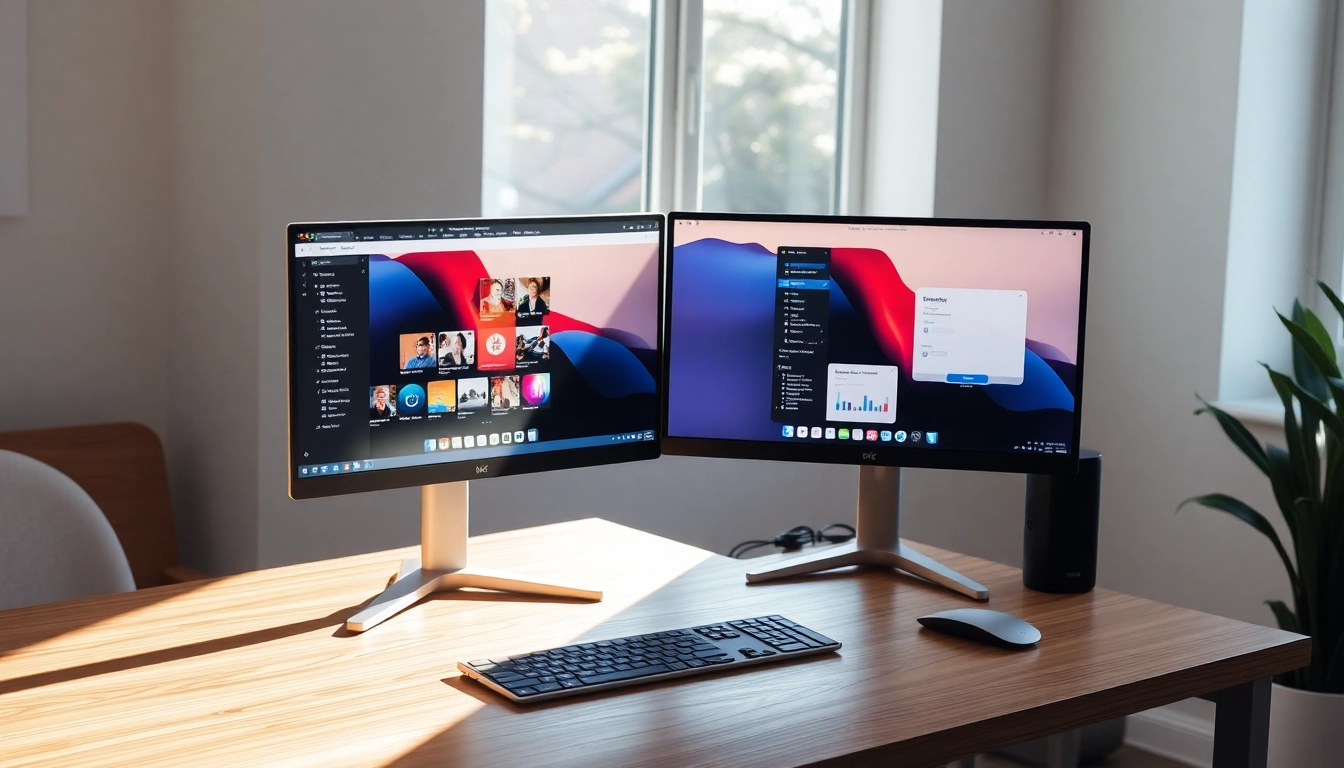
Understanding Dual Monitor Install: A Comprehensive Guide
As we delve into the importance of streamlined workflows and enhanced productivity, the dual monitor install emerges as a game-changer. This setup not only caters to the needs of tech enthusiasts and professionals alike, but it also transforms mundane tasks into engaging experiences. By enabling multiple displays, individuals can effortlessly multitask, compare information side-by-side, and significantly elevate their overall efficiency.
What is a Dual Monitor Setup?
A dual monitor setup involves connecting two separate monitors to a single computer system, allowing users to extend their visual workspace. This configuration can be beneficial across a variety of tasks, including programming, graphic design, gaming, and general office work. The flexibility of dual monitors provides users the ability to keep multiple applications open simultaneously, facilitating easier access to crucial information without the need to switch back and forth between windows.
Benefits of Using Dual Monitors
- Increased Productivity: Research suggests that dual monitors can boost productivity by up to 30%. The expanded workspace encourages users to minimize distractions and maintain focus.
- Enhanced Multitasking: With applications open on separate screens, users can streamline their workflows, making it easier to manage tasks like data entry, research, or design work.
- Improved Collaboration: In collaborative environments, dual monitors facilitate easier sharing of information, allowing for better interaction during meetings and presentations.
- Greater Comfort: Reducing the need for constant window switching can alleviate eye strain and neck discomfort caused by extended computer use.
Compatibility Checks Before Installation
Before proceeding with a dual monitor install, it’s essential to ensure that your hardware supports multiple displays. Check that your computer’s graphics card or integrated graphics can handle the additional output. Most modern graphics cards offer multiple ports (HDMI, DisplayPort, DVI), but older systems may require upgrades. Verify that your operating system supports dual displays, which is standard in Windows, macOS, and most Linux distributions.
Essential Equipment for a Dual Monitor Install
Types of Monitors Required
Choosing the right monitors can significantly impact your dual monitor experience. Key considerations include:
- Size: Monitors typically range from 21 inches to 34 inches. Larger screens can provide more visual space, but consider your available workspace.
- Resolution: Opt for displays with at least 1080p resolution for crisp and clear visuals. Higher resolutions enhance detail, important for design and gaming.
- Panel Technology: In-Plane Switching (IPS) panels offer better color reproduction and viewing angles, making them ideal for creative work.
Necessary Cables and Adapters
The correct cables are fundamental for connecting your monitors. The most common options include:
- HDMI: Suitable for both video and audio. Most modern monitors and computers come with HDMI ports.
- DisplayPort: Common in gaming monitors, DisplayPort provides higher refresh rates and resolutions compared to HDMI.
- DVI: Primarily used for older monitors, DVI supports high resolutions but lacks audio support.
- Adapters: Depending on your monitor and computer’s ports, you may need adapters to connect different cable types.
Tools for Mounting and Setup
Depending on your workspace setup, you might need additional tools:
- Monitor Stands or Mounts: Stands can elevate monitors for a more ergonomic viewing angle. Mounts save desk space and allow flexible positioning.
- Screws and Fasteners: If you choose wall mounting, ensure that you have suitable hardware to secure your monitors.
- Cable Management Tools: Cable ties and clips help organize cables, maintaining a clean workspace.
Step-by-Step Dual Monitor Install Process
Powering Off and Connecting Monitors
Begin by powering down your computer and monitors. This ensures safety during installation. Connect your first monitor using the primary output on your computer, typically an HDMI or DisplayPort. Next, connect your second monitor to the secondary output, ensuring both are properly seated in their respective ports. Once connected, power on the monitors and your computer.
Adjusting Display Settings in Windows
After powering on your computer, right-click on the desktop and select Display settings. From here, you can arrange your monitors to your preferred configuration:
- Select the monitor you wish to adjust.
- Choose whether to extend or duplicate displays.
- Adjust resolution settings if necessary.
- Set your main display as needed.
For detailed instructions tailored to your specific operating system, refer to the Microsoft Support page on using multiple monitors (Microsoft Support).
Troubleshooting Common Setup Issues
If one of your monitors isn’t displaying anything, try the following solutions:
- Ensure all cables are securely connected.
- Right-click on the desktop, go to Display settings, and check if the monitor appears in the arrangement.
- Try switching cables or ports to identify a potentially faulty connection.
- Update your graphics card drivers to the latest version.
Optimizing Your Dual Monitor Experience
Best Display Arrangements
The way you arrange your monitors can greatly affect your workflow. Here are some optimal setups:
- Side-by-Side: This is the most common arrangement, allowing easy access between screens.
- One Above the Other: This setup is great for depth, especially useful for tasks that require a lot of vertical space.
- Angle Configurations: Tilting the monitors inward can create a more immersive experience, especially beneficial for gaming or design work.
Productivity Tips with Dual Monitors
To maximize the benefits of a dual monitor setup, consider these productivity tips:
- Use Shortcuts: Familiarize yourself with keyboard shortcuts for moving windows between screens rapidly.
- Organize Windows: Use window management tools to snap windows to the edges of your monitors for improved workspace organization.
- Prioritize Tasks: Keep essential applications on your primary monitor and use the secondary for secondary tasks or reference materials.
Maintaining Your Monitor Setup
Ensuring longevity and optimal performance requires regular maintenance:
- Keep screens clean and dust-free.
- Regularly check and manage cables to prevent tangling or damage.
- Occasionally recalibrate monitor settings for color accuracy, especially if used for design work.
Advanced Techniques for a Dual Monitor Install
Using Multiple Displays on Different Operating Systems
While Windows is the most popular operating system for dual displays, other systems like macOS and Linux also offer robust support. Mac users can utilize the System Preferences to arrange displays, while Linux users can use tools such as xrandr to configure their multi-monitor setup. Each operating system has unique setups and adjustments, so it’s essential to familiarize yourself with the settings they offer.
Configuring Dual Monitors for Gaming
For gaming enthusiasts, utilizing dual monitors can enhance the gaming experience significantly. Here are some recommendations:
- Choose Monitors with Fast Refresh Rates: Low input lag and high refresh rates are crucial for competitive gaming.
- Utilize Gaming Software: Some games support dual-screen setups for panoramic views, providing a more immersive gaming environment.
- Manage Performance Settings: Adjust graphical settings for optimal performance, ensuring smooth gameplay across multiple displays.
Integrating Monitor Calibration and Color Settings
For professionals in fields like graphic design or photography, monitor calibration is fundamental to ensure color accuracy. Tools such as color calibration software or hardware can help achieve precise color settings across monitors. Regular calibration checks are recommended to maintain consistency in your work.





